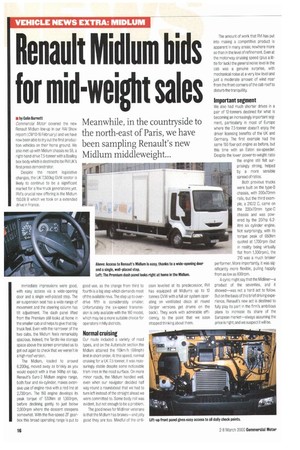Renault Midlum bids for mid-weight sales
Page 18

If you've noticed an error in this article please click here to report it so we can fix it.
Meanwhile, in the countryside to the north-east of Paris, we have been sampling Renault's new Midlum middleweight...
• by Colin Barnett Commercial Motor covered the new Renault Midlum line-up in our RAI Show report ( CM10-16 February) and we have now been able to try out the first production vehicles on their home ground. We also met up with Midlum chassis no 58, a right-hand-drive 7.5-tonner with a Boalloy box-body which is destined to be RVI UK's first press demonstrator.
Despite the recent legislative changes, the UK 7,500kg GVW sector is likely to continue to be a significant market for a few truck generations yet. RVI's crucial new offering is the Midlum 150.08 B which we took on a extended drive in France.
Immediate impressions were good, with easy access via a wide-opening door and a single well-placed step. The air-suspension seat has a wide range of movement and the steering column has tilt adjustment The dash panel lifted from the Premium still looks at home in the smaller cab and helps to give that bigtruck feel. Even with the narrower of the two cabs, the Midlum feels remarkably spacious. Indeed, the Tardis-like storage space above the screen prompted us to get out again to check that we weren't in a high-roof version.
The Midlum, loaded to around 6,200kg, moved away as briskly as you would expect with a true 148hp on tap. Renault's Euro-2 Midlum engine range, both four and six-cylinder, makes extensive use of engine revs with a red line at 2,700rpm. The 150 engine develops its peak torque of 530Nm at 1,500rpm, before deckling gently to just below 2,000rpm where the descent steepens somewhat. With the five-speed ZF gearbox this broad operating range is put to good use, as the change from third to fourth is a big step which demands most of the available revs. The step up to overdrive fifth is considerably smaller. Unfortunately the six-speed transmission is only available with the 180 model, which may be a more suitable choice for operators in hilly districts.
Normal cruising
Our route included a variety of road types, and on the Autoroute section the Midlum attained the 110km/h (68mph) limit in short order. At this speed, normal cruising for a UK 7.5-tanner, it was reassuringly stable despite some noticeable tram lines in the road surface. On more minor roads, the Midlum handled well, even when our navigator decided half way round a roundabout that we had to turn left instead of the straight ahead we were committed to. Some body roll was evident, but not enough to be a problem.
The good news for Midliner veterans is that the Midlum has brakes—and jolly good they are too. Mindful of the criti
cism levelled at its predecessor, RVI has equipped all Midlums up to 12 tonnes GVW with a full air system operating on ventilated discs all round (larger versions get drums on the back). They work with admirable efficiency, to the point that we soon stopped thinking about them. The amount of work that RVI has put into making a competitive product is apparent in many areas; nowhere more so than in the level of refinement. Even at the motorway cruising speed (plus a little for luck) the general noise level in the cab was a genuine surprise, with mechanical noise at a very low level and just a moderate amount of wind roar from the front corners of the cab roof to disturb the tranquillity.
Important segment
We also had much shorter drives in a pair of 12-tanners destined for what is becoming an increasingly important segment, particularly in most of Europe where the 7.5-tonner doesn't enjoy the driver licensing benefits of the UK and Germany. The first example had the same 150 four-pot engine as before, but this time with an Eaton six-speeder. Despite the lower power-to-weight ratio the engine still felt surprisingly strong, helped by a more sensible spread of ratios.
Bath previous trucks were built on the type-B chassis, with 200x7Ornm rails, but the third example, a 210.12 C, came on the 220x70mm type-C chassis and was powered by the 207hp 6.2hire six cylinder engine. Not surprisingly, with its torque peak of 650Nm quoted at 1,700rpm (but in reality being virtually flat from 1,300rpm), the 210 was a much brisker performer. More importantly, it was significantly more flexible, pulling happily from as low as 800rpm.
A cynic might say that the Midliner—a product of the seventies, and it showed—was not a hard act to follow. But on the basis of this brief driving experience, Renault's new act is destined to fully play its part in the firm's ambitious plans to increase its share of the European market—always assuming the price is right; and we suspect it will be.








































































































